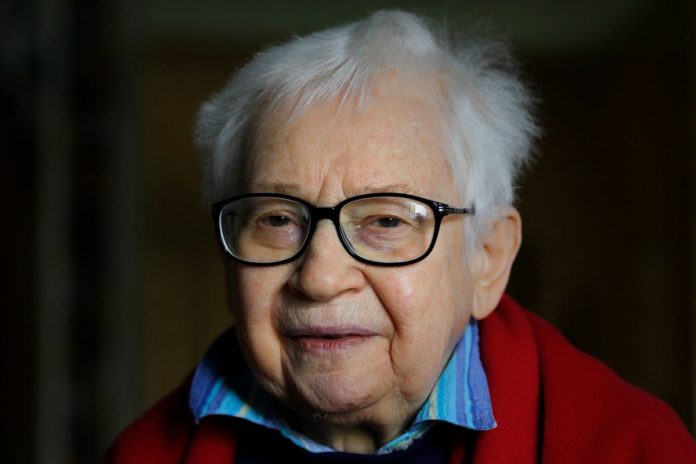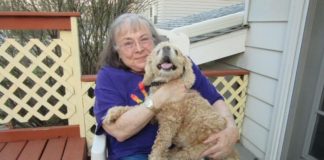
Revered as the first openly gay photojournalist to be published in the US, Kay Lahusen, who has died aged 91, was one of the most prominent and influential gay rights activists campaigning in America throughout the second half of the 20th century. Coming of age during the 1950s, she recorded the early picketing in both Washington DC and Philadelphia as well as at the Pentagon and the White House. While her extensive output has been widely shared for decades, her images have also remained an invaluable guide to the characters, events and movements in LGBT+ history. She may not have looked like a revolutionary, but there can be little doubt that she was.
The only daughter of a Cincinnati car mechanic, Katherine Lahusen, universally known as Kay, spent much of her childhood in the care of her grandparents, George and Katherine. Brought up in a somewhat intellectual household with strict Christian Science values, she also relished life in the great outdoors – American football, horse riding, shooting, archery – and at summer camp she enjoyed success in the boxing ring. Her interest in photography began after she received a tiny box camera as a gift. Educated initially at a private girls’ school, she graduated from Withrow High School in 1948. She had intended to become an architect, but instead read English at Ohio State University.
It was there that she began her first serious relationship, which lasted for six years. When her partner left her to get married, a devastated Lahusen then moved to Boston, becoming a reference librarian for The Christian Science Monitor. While looking to explore her sexuality, she came across a book, Voyage from Lesbos, written by Robert Robertiello, in which he claimed to have “cured” three lesbians. Lahusen sought him out and told him that she did not want to be cured but to find more like-minded women. Robertiello guided her to the Daughters of Bilitis (DOB), the first lesbian activist group in the US, who published The Ladder, America’s first nationally distributed lesbian magazine.
After attending the group’s meetings for a while, it was in 1961, at a DOB picnic in Rhode Island, that Lahusen first met Barbara Gittings. Born in Vienna in 1932, the daughter of a US foreign service diplomat, Gittings is regarded by many as the mother of the gay rights movement. The pair subsequently became a couple, remaining together for 46 years until Gittings’s death in 2007. Both became major contributors to The Ladder, Gittings as editor and Lahusen as art editor. They persistently sought to change the magazine’s title to A Lesbian Review, but the board of the DOB would only approve its use as a subtitle. In response, they kept making the font larger.
Lahusen (right) among demonstrators calling for the protection of homosexuals from discrimination in 1976
” height=”2006″ width=”3000″ srcset=”https://static.independent.co.uk/2021/06/16/12/SEI80741528.jpg?width=320&auto=webp&quality=75 320w, https://static.independent.co.uk/2021/06/16/12/SEI80741528.jpg?width=640&auto=webp&quality=75 640w” layout=”responsive” i-amphtml-layout=”responsive”> Lahusen (right) among demonstrators calling for the protection of homosexuals from discrimination in 1976 (AP)
Although women in loving relationships with other women have been producing art for centuries, the transition to an increased openness was expedited by Lahusen’s numerous contributions to the magazine. She was instrumental in reducing its dependence on simple line drawings, replacing them with her own photographs. Initially shot from behind, in shadow, or behind sunglasses to protect people’s identities, all this changed after 1966, when Lilli Vincenz, a prominent lesbian activist, posed for the magazine’s cover with her face in full view. By the end of Lahusen’s time with the publication, there was a waiting list of women eager and willing to follow Vincenz’s example.
Lahusen contributed articles at The Ladder and elsewhere under the pseudonym Kay Tobin, which was a name she reportedly found in the phone book and thought would be far easier for people to remember than her own. Both her writings and photographs acted as a cornerstone of the New York-based Gay News Weekly. In 1972, alongside fellow activist Randy Wicker, Lahusen profiled many of the movement’s early leaders in a volume titled The Gay Crusaders. A further collaborative project, this time with Tracy Baim, was a book paying tribute to her former partner, Barbara Gittings: Gay Pioneer. Her work also featured in the recent book Love and Resistance: Out of the Closet into the Stonewall Era.
From 1965 until 1969, Lahusen organised and led the “Annual Reminder” protests, held every year on 4 July in front of Philadelphia’s Independence Hall. Going on to co-found the Gay Activists Alliance in 1970, she is said to have pounded on the roof of the limousine of the former Supreme Court justice Arthur Goldberg, then running for New York governor, after he told her that he had more important things to do than talk about gay rights. He eventually released a more conciliatory statement. Two years later, she played a pivotal role in persuading the American Psychiatric Association to strike homosexuality from its Diagnostic and Statistical Manual of Mental Disorders (DSM).
Latterly, having dealt in real estate, Lahusen moved into an assisted living facility, where she regularly hosted “the gay table” in the dining room. This she greatly missed when the Covid-19 pandemic forced everyone to eat alone in their rooms. Her ashes will now be interred alongside those of her former partner in a bench designed to express their love for one another. It bears the words, “Gay Is Good.”
Kay Lahusen, photographer and activist, born 5 January 1930, died 26 May 2021








